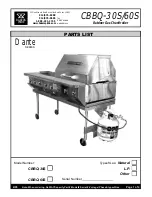
Benchmark 1500 - 2000 Boilers
CHAPTER 5 – MODE OF OPERATION
Page
66
of
184
AERCO International, Inc.
•
100 Oritani Dr.
•
Blauvelt, NY 10913
OMM-0097_0C
Ph.: 800-526-0288
GF-142
5.6.2 ACS Setup and Startup
This mode of operation is factory preset and the ACS controls the firing rate (air/fuel valve %
open position). There are no setup instructions for each individual unit.
To operate the unit in manual mode, press the
AUTO/MAN
switch. The
REMOTE
LED will go
off and the
MANUAL
LED will light
To change back to the ACS mode, simply press the
AUTO/MAN
switch. The
REMOTE
LED will
again light and the
MANUAL
LED will go off.
5.7 COMBINATION CONTROL SYSTEM (CCS)
NOTE
Only ACS can be utilized for the Combination Control System.
A Combination Control System (CCS) is one that uses multiple boilers to cover both space-
heating and domestic hot water needs. The theory behind this type of system is that the
maximum space-heating load and the maximum domestic hot water load do not occur
simultaneously. Therefore, boilers used for domestic hot water are capable of switching
between constant setpoint and ACS control.
For a typical CCS, an adequate number of boilers are installed to cover the space-heating load
on the design-day. However, one or more units are used for the domestic hot water load as well.
These boilers are the combination units and are referred to as the combo boilers. The combo
boilers heat water to a constant setpoint temperature. That water is then circulated through a
heat exchanger in a domestic hot water storage tank.
Only the AERCO Control System (ACS) is necessary to configure this system if only a single
valve is used to switch from space heating to domestic hot water. However, the ACS Relay
Panel is required in combination with the ACS when there are up to two isolation valves, boiler
interlocks, and/or a Domestic Hot Water (DHW) pump in a Combination heating plant where
AERCO boilers are being used for both Building Heat and Domestic Hot Water heating.
The following two options are available for using a combination system; one that uses only the
ACS, and one that requires the optional ACS Relay Box:
•
OPTION 1
- This option is selected when the ACS controls a boiler plant containing up to
eight combination boilers that are Domestic Hot Water Priority (DHW PRIORITY) boilers,
along with building heat (BLDG HEAT) boilers, and
one
hydronic isolation valve in the main
header between the BLDG HEAT boilers and the DHW PRIORITY boilers.
•
OPTION 2
– When this option is selected, the ACS Relay Panel must be used in
conjunction with the ACS. For this option, the ACS controls a boiler plant containing up to
eight combination boilers that are divided up into Building Priority (BLDG PRIORITY)
boilers and Domestic Hot Water Priority (DHW PRIORITY) boilers, along with building heat
(BLDG HEAT) boilers, and using
two
hydronic isolation valves in the main header, one
between the BLDG HEAT and BLDG PRIORITY boilers, and the other between the BLDG
PRIORITY and the DHW PRIORITY boilers.
In Option 2, when the space-heating load is such that when all the space-heating boilers are at
the 100% valve position, the ACS will then ask the ACS Relay Box for the domestic boilers to
become space-heating boilers. Provided the domestic hot water load is satisfied, the combo (hot
water) boilers will then become space-heating boilers. If the domestic hot water load is not
satisfied, the combo boiler(s) remain on the domestic hot water load. If the combo boilers switch
over to space heating, but there is a call for domestic hot water, the ACS Relay Box switches
the combo units back to the domestic load. The ACS in combination with the ACS Relay Box
















































